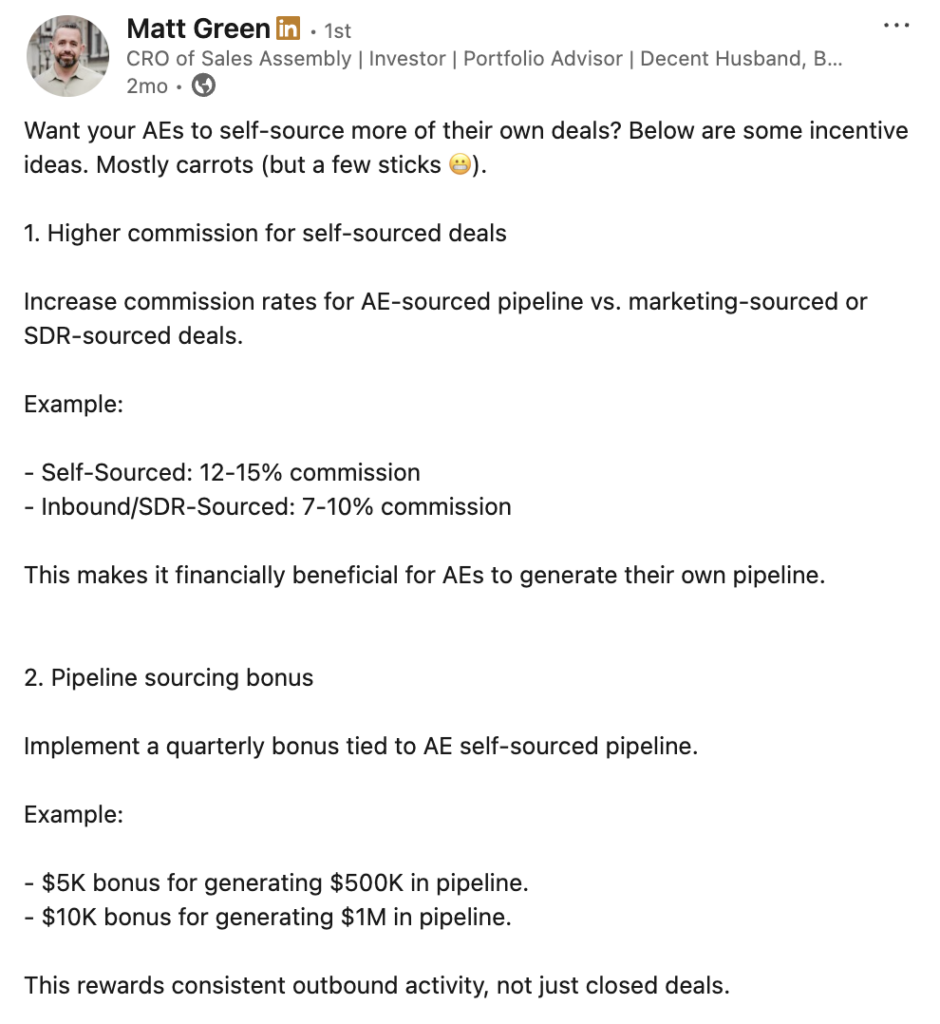Don’t sleep on incentivizing self-sourced deals.
“Self-sourced deals provide a level of risk mitigation across the entire go-to-market organization and give reps some level of control over their own deals,” according to Matt Green, Chief Revenue Officer for Sales Assembly.
Who is Matt Green?
Matt has led sales and operations for multiple hyper-growth, venture-backed tech companies, overseeing personnel management, strategic planning, and sales leadership. Now, he helps run Sales Assembly, the first and only Scale-as-a-Service platform for the most exciting B2B tech companies in the world.
The leader had a lot to say on this topic recently via his LinkedIn post, which included eight incentive ideas to motivate AEs to self-source more of their own deals.
We couldn’t help but want to learn more from Matt.
First, a couple of ideas and examples from Matt’s post:

Now, let’s dive into the highlights of our Q&A session with Matt.
How to Incentivize Self-Sourced Deals: Q&A
With the rise of RevOps and automated outbound, why are self-sourced deals still important?
Matt: From the standpoint of a rep, it’s important to have some level of control over your own destiny. If you’re not getting leads from somewhere else, you’re taking ownership of the opportunity to fill your own pipeline and generate your own revenue. If the deals you close from your self-sourcing activities end up as icing on the cake, you’re well exceeding quota instead of simply hitting it.
At an organizational level, self-sourcing is important for two reasons. One, buying behavior doesn’t necessarily always follow a company’s routing rules. Automated, outbound, and all these systems can definitely fuel scale. However, self-sourcing is a way to maintain some level of ownership, allowing reps to break through the noise.
This forces reps to build their own momentum, helps sharpen the message, and does a great job of connecting the sellers to the actual pain that they’re looking to solve. It’s different when sellers uncover the problem themselves. They’re not just reading notes in Salesforce. They’re walking into a conversation with context, urgency, and a point of view.
Lastly, from an organizational perspective, ensuring that your reps are self-sourcing their own deals de-risks the overall go-to-market (GTM) machine, as you’re no longer relying on inbound or SDRs to do the work. For instance, if you go through a dry month or quarter, you can’t sit there and say we’re missing our number. You must make it up somehow. Self-sourcing provides a level of risk mitigation across the entire GTM organization.
They’re not just reading notes in Salesforce. They’re walking into a conversation with
— Matt Green
context, urgency, and a point of view.
Of all the incentive structures you shared, which one do you find to be the most effective in driving consistent outbound behavior from AEs, and why?
Matt: Keeping it simple is important. So, I like the idea of a split attainment target where, for instance, 70% of your quota comes from inbound deals or partner-sourced deals, but 30% must be self-sourced. Whatever the ratios are, keep it simple and straightforward. I mean, no SPIFs, no funny math, just clear expectations tied directly to what gets paid.
This approach creates real accountability without over-rotating on volume. With this setup, reps can’t coast on inbound alone, but they’re not drowning in activity quotas. I like the 70/30 split because the lion’s share of your deals are from marketing or SDRs.
At the same time, reps are held accountable for self-sourcing. However, it’s not to such a great extent that we’re tracking the number of emails sent daily. It’s outcome over input, and the math reinforces the balance.
Design, track, and manage variable incentives with QuotaPath. Give your RevOps, finance, and sales teams transparency into sales compensation.
Talk to SalesHow should RevOps and Sales leaders approach striking the right balance between incentives and accountability when implementing a minimum prospecting quota?
Matt: You always start with the carrot. Then you layer the stick behind it.
Prospecting quotas, or any quotas, fall flat when they feel arbitrary. There must be some reasoning behind it. It’s important to start by showing reps the reason why.
Show them what percentage of closed revenue last quarter came from rep-sourced deals. Then explain the upside for reps who consistently self-source. Like anything else in leadership, make the expectations visible and non-negotiable.
For example, let’s say you know the baseline is 8 touches per day or 2 meetings per week. Whatever metric you want to track, you must make it gospel, review it weekly, coach it, reinforce it, and drive accountability. Show reps what good looks like, and the stick should be consistency and visibility.
Some leaders make the mistake of only starting to enforce this when the pipeline is low. Then, it seems reactionary and arbitrary. It must be part of the GTM organization’s DNA in good times and bad.
Then, for top performers, who have been doing those activities, it becomes an easy narrative to reinforce. For instance, ‘You’re here because you’ve been doing all this. So, let’s keep doing it so you remain here (at the top).’ It’s a self-reinforcing type of philosophy.
Some leaders make the mistake of only starting to enforce this when the pipeline is low. Then, it seems reactionary and arbitrary. It must be part of the GTM organization’s DNA in good times and bad.
How can organizations effectively track and validate self-sourced deals to avoid disputes around lead ownership?
Matt: Attribution and ownership can get tricky. I like simple rules. If you touched it first and that touch created momentum, it’s yours, regardless of what happened after the fact. But to make that work at scale, this goes back to every RevOps leader’s favorite subject: CRM hygiene. You must use a dedicated source by field in Salesforce or HubSpot, locked in at the first meaningful touch, booked meeting, or qualified reply.
The reps have to take ownership of tagging sourcing at stage one or stage two, not when the deal hits the pipeline, but before that. If they want credit for it, they need to take the extra two seconds in the CRM to record what they did. Then, RevOps leaders can layer in reporting that shows source to conversion so they can spot sandbagging or cherry picking, for instance.
If all that fails, the great thing about emails is that they’re timestamped. You can easily return to where the momentum first began. That’s why we ensure everything is automatically synced with Salesforce or HubSpot, so all communication is logged to help prove ownership.
If a company is new to incentivizing self-sourcing, what’s a simple version of this model they can pilot within one quarter?
Matt: Rather than redesign their entire comp plan, they can start with a commission on self-sourced deals for the quarter. For instance, have a 10 to 20% kicker on all self-sourced deals. There’s no extra quota math or turf wars because it’s only one quarter and a little extra commission.
Add tracking and accountability by tracking things weekly. For example, track the percentage of meetings booked from the rep-led outbound percentage of pipeline that’s self-sourced and the win rate on the rep source versus inbound. That way, after the quarter, you have a good story to tell, and you can celebrate the top three performers.
Use those data points to reinforce the motion and decide whether to go deeper. You’ve proven that this works, it’s viable, and people are actually doing it. Then, you can adjust the comp plan and quota expectations. So, start simple, incentivize the behaviors you want, and reward the results.
Any final thoughts, tips, or ideas you’d like to add?
Matt: I know this topic is controversial. I got a lot of pushback on my LinkedIn post. Some said reps shouldn’t be wasting their time sourcing. I would reinforce again that unless you can 100% guarantee your inbound is never going to dry up and your SDRs are always going to be able to book meetings, it makes sense to mitigate some level of risk within your go-to-market engine by having your reps self-source some of their own pipeline.
You never know, you may run into a dry month or quarter and regret not having your reps engage in these types of activities leading up to it. And if you wait for a dry month or quarter to go talk to Marketing, who’s hitting quota while you’re talking to them? Are we meeting our target, or are we falling short of it?
Choose the one you like. Which would you prefer? It’s as simple as that!
Thank you, Matt, for sharing your insights with us!
Try the most collaborative solution to manage, track and payout variable compensation. Calculate commissions and pay your team accurately, and on time.
Start TrialTo learn how QuotaPath helps your team visualize and track their earnings while making it easier for leaders to incentivize specific selling behaviors, chat with our team today.



